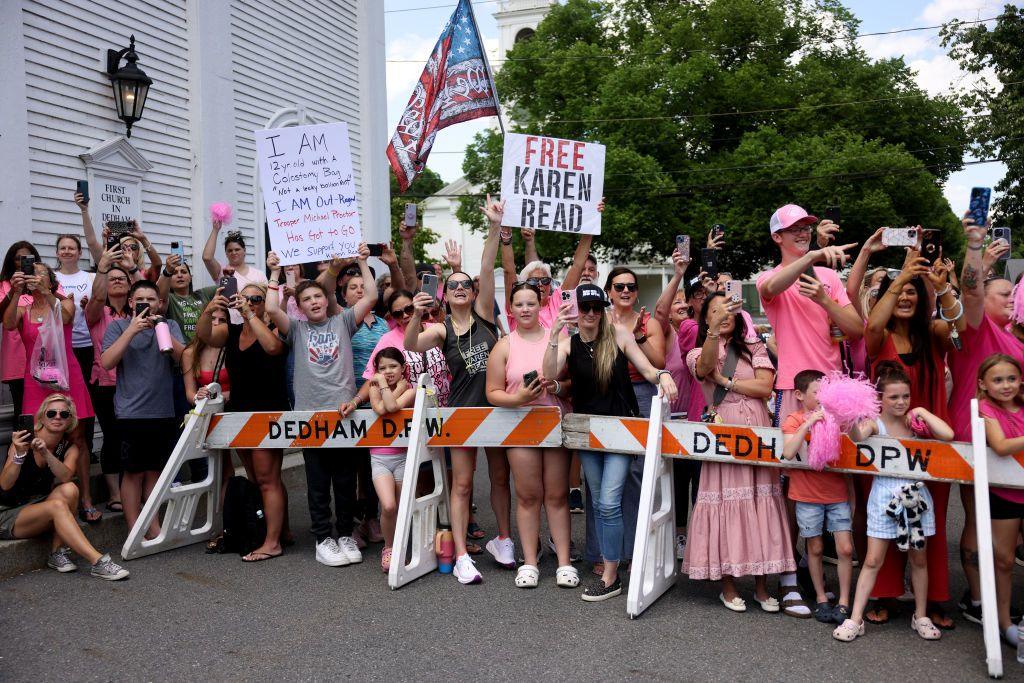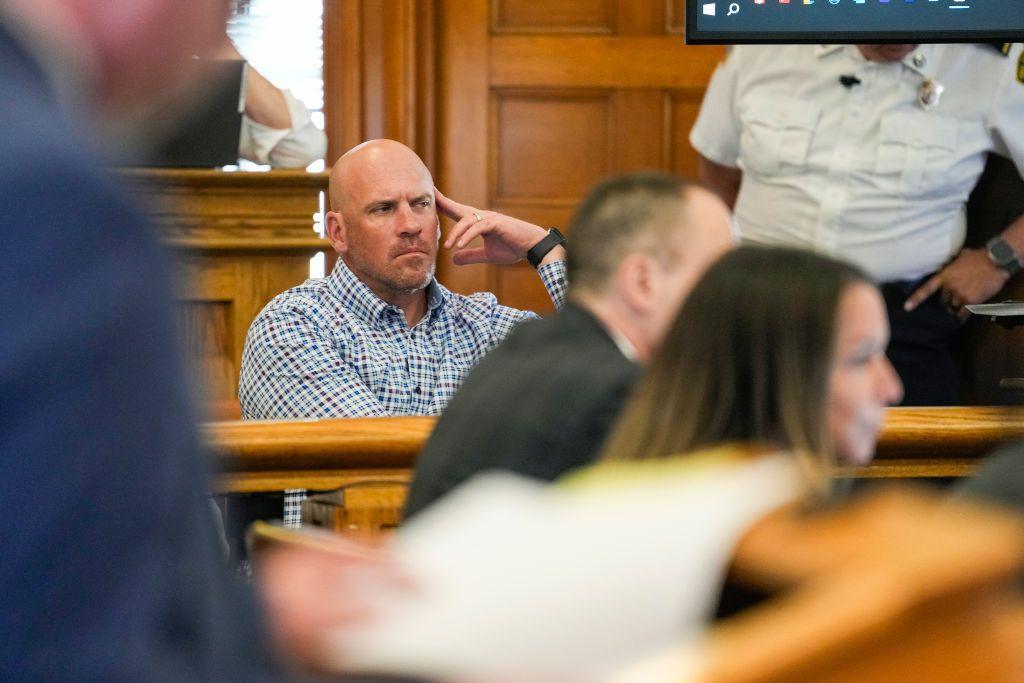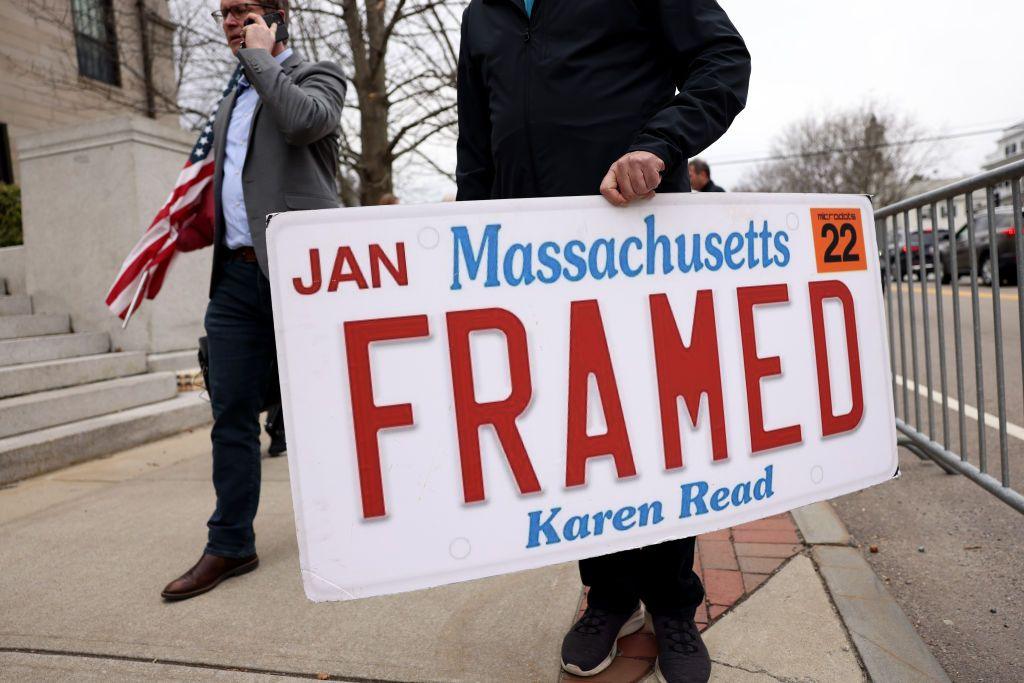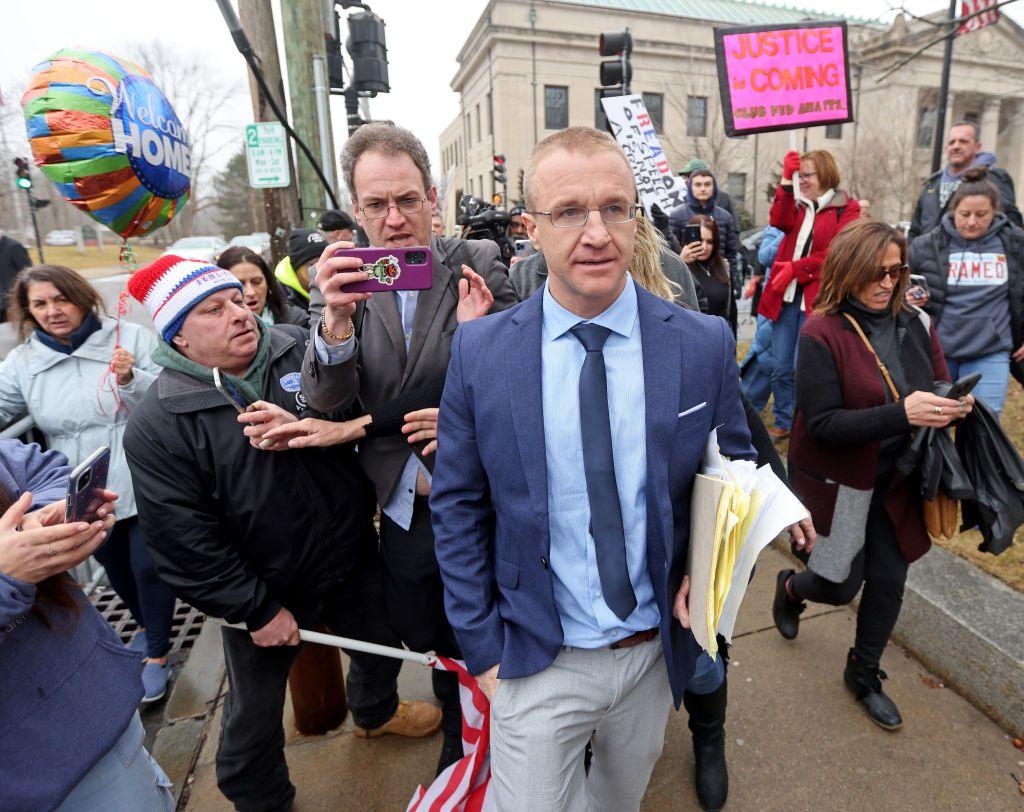What to know about Karen Read's second murder trial

- Published
Karen Read, the Massachusetts woman accused of killing her police officer boyfriend in 2022, has been found not guilty of murder, ending one of the most watched trials in recent history.
Ms Read's first trial collapsed in July 2024 after the jury could not reach a verdict.
Her boyfriend, Boston police officer John O'Keefe, was found unresponsive in the snow outside a colleague's suburban home and later pronounced dead.
Ms Read faced multiple charges and was accused of dropping Mr O'Keefe off at a fellow police officer's home after a night of drinking, hitting him with her car and driving away from the scene.
The legal saga has drawn large crowds to the Massachusetts courthouse where her second trial began in April.
Here's everything you need to know about the case.

Supporters of Karen Read routinely gather outside the courthouse
How did the second trial go?
The jury found Ms Read not guilty of vehicular manslaughter while intoxicated and leaving the site of the collision. But she was convicted of driving while intoxicated.
As the verdict was read out, a loud cheer could be heard inside the courtroom from outside the Massachusetts courthouse where a large crowd had gathered, many wearing pink to show support for Ms Read. She hugged her defence attorneys and cried after the verdict was announced.
Prosecutors and Ms Read's attorneys agreed to a one-year probation sentence for the intoxication charge, typical for a first-time offender.
The crowd outside, chanted "Free Karen Read" and made "I love you" signs in American Sign Language.
Testimony during the trial included expert witnesses evaluating location data from Mr O'Keefe's phone, as well as a survey of damage to Ms Read's vehicle.
Among those called to testify was Jen McCabe, a friend of Mr O'Keefe and Ms Read, who was inside the house during the party.
Ms McCabe testified she was expecting the couple, that she saw a car she believed to be Ms Read's, but that they never came inside the house.
According to evidence introduced during the trial, Ms McCabe also searched for "how long to die in the cold" on her phone, although there was conflicting testimony as to when exactly she carried out the search.
Ms McCabe was one of the people who found Mr O'Keefe outside the house along with Ms Read the following morning.
The prosecution witness list also included a state trooper who was fired after he disclosed during the first trial that he used unprofessional language to describe Ms Read, and two other policemen who were formally disciplined after the first trial.
In their closing arguments, prosecutors zeroed in on Ms Read's own statements to a documentary series, in which she said, "I didn't think I hit him," referring to Mr O'Keefe, but that she may have "clipped him."
The defence, meanwhile, suggested that Ms Read was framed by law enforcement officers in Mr O'Keefe's social circle. They pointed to "obvious dog bites" on his arm and a head injury he suffered from falling backwards, arguing he was beaten then left outside in the cold.
Protesters have been banned from the areas around the courthouse, to reduce the risk of influencing the jurors.
Ms Read gave several media interviews after declining to take the stand in her first trial. She also gave permission to HBO to create the mini-series, A Body in the Snow: The Trial of Karen Read, which has been watched by millions.
"I have nothing to hide," Ms Read told Boston 25 News in February. "My life is in the balance, and it shouldn't be. The more information the public has, the more they understand what we already know."
She did not testify in the second trial.
Who are Karen Read and John O'Keefe?
Before the case, Ms Read, 44, worked as an adjunct professor at Bentley University and an equity analyst at Fidelity Investments.
She and Mr O'Keefe were together for about two years before his 2022 death, but the latter part of the pair's relationship was troubled, prosecutors argued.
Mr O'Keefe, who died at age 46, spent 16 years with the Boston Police Department.
What did prosecutors allege?
Prosecutors alleged the couple were drinking the evening before Mr O'Keefe's body was found.
Ms Read allegedly dropped her boyfriend off at a house party. When leaving she made a three-point turn, struck Mr O'Keefe, then drove away, according to prosecutors.
She returned to the party a few hours later with two other women and found Mr O'Keefe in a snowbank.
His cause of death was later determined to be blunt force trauma to the head and hypothermia, NBC News reported.
Throughout their case, prosecutors alleged the couple had a rocky relationship.
They claimed Ms Read intentionally struck her then-boyfriend with her car because of their relationship problems.
Mr O'Keefe's brother, Paul O'Keefe, was among witnesses called to the stand who detailed the couple's disagreements.

John O'Keefe's brother, Paul O'Keefe, was among the people who testified during the murder trial
What did the defence argue?
In her first trial, Ms Read did not take the stand as part of her defence, although she had the option of testifying during the second trial.
Her lawyers argued that investigators had inappropriate relationships with witnesses and others involved in the case.
The defence claimed Mr O'Keefe was beaten inside the house party and later dragged outside where he was found. They alleged that a police cover-up resulted in Ms Read being framed.
Much of the case they presented in the first trial focused on what the defence called a poorly done investigation into O'Keefe's death by local law enforcement.
Some of the investigators who oversaw the case knew the police officers who attended the house party that January night, the defence claimed.
For example, the lead investigator, Massachusetts State Trooper Michael Proctor, admitted he was friends with the the Boston police officer who hosted the party where Mr O'Keefe died.
Ms Read was a "convenient outsider" who was targeted to ensure investigators did not look at other suspects, the defence alleged.
Among the witnesses who took the stand as part of the defence's case was a retired forensic pathologist, Dr Frank Sheridan.
He claimed that Mr O'Keefe's body would have had more bruising if it were hit by a heavy vehicle.

Many Karen Read supporters believe she was framed for her former boyfriend's murder
Who is 'Turtleboy'?
Aidan Kearny, also known as "Turtleboy", is an intriguing character to have come out of this trial.
He now faces charges for allegedly intimidating witnesses involved with the trial.
Mr Kearny runs the website "TB Daily News" where he writes under the name "Turtleboy".
He had asserted that Ms Read was innocent and had followed the case closely.
His writing frequently questioned the investigation into Mr O'Keefe's death and he often publicly confronted witnesses about the case.
During the case, prosecutors shared several examples of witness intimidation with the jury.

Aidan "Turtleboy" Kearney, who covered the case for a local website
Mr Kearny was charged with witness intimidation in October 2023 and later pleaded not guilty.
"They will never shut me up, they will never, ever, ever stop me from reporting the truth about what happened to John O'Keefe," Mr Kearney told reporters after his 2023 arraignment. "Reporting the news is not harassment. Asking questions is not harassment."
In December, he was indicted again. This time on 16 new charges that include witness intimidation and conspiracy to intimidate witnesses.
Prosecutors alleged Mr Kearny and Ms Read were in communication and she was sharing information from the case that was not yet public.
Judge Cannone, who was overseeing the case, ruled Mr Kearny would have to leave the courtroom when certain witnesses testified because of the witness intimidation charges brought against him.
Related topics
- Published1 July 2024
